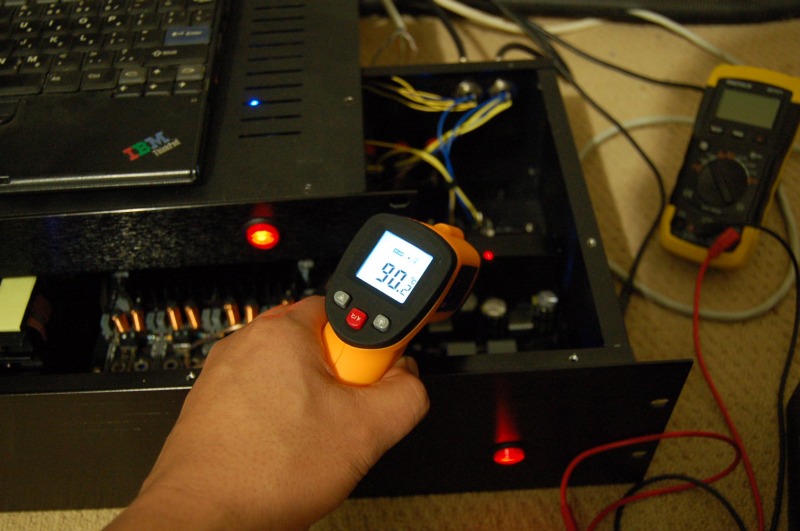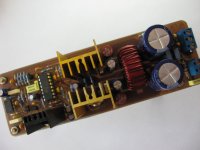Based on FTC?... I don't understand.
yes, the American FTC trade regulations of 1974, it requires preconditioning of 1 hour at 1/3 power and full power testing for 5 minutes....using a dummy load, signal generator and scope/distortion meter.....
I haven't put my amp into 'full-time' service yet, but I realize there may be heat issues if run for extended periods without additional cooling measures. Luckily I have vents in the top of my enclosure, but that may not be enough to dissipate the heat over the long haul. I may have to add a fan to HS.
No, I have not.yes, the American FTC trade regulations of 1974, it requires preconditioning of 1 hour at 1/3 power and full power testing for 5 minutes....using a dummy load, signal generator and scope/distortion meter.....
Vents in the bottom would help by letting cool air in.
I haven't put my amp into 'full-time' service yet, but I realize there may be heat issues if run for extended periods without additional cooling measures. Luckily I have vents in the top of my enclosure, but that may not be enough to dissipate the heat over the long haul. I may have to add a fan to HS.
Unfortunately, the case I'm using has no vents on the bottom. I thought these class D amps were designed to run cooler. Isn't that part of the marketing hype associated with class D amps? 😀Vents in the bottom would help by letting cool air in.
I'm pretty sure the amps they're supposed to run cooler than have vents in the bottom.
Any reason you can't drill some strategically placed holes?
Any reason you can't drill some strategically placed holes?
Yeah, drilling holes won't be a problem if I go that route. I'd like to run in the amp more and take some temp measurements to see where it tops out under my typical operating conditions.I'm pretty sure the amps they're supposed to run cooler than have vents in the bottom.
Any reason you can't drill some strategically placed holes?
I have another class D amp that's based on the popular LJM design configured as two little monoblocks. With initial testing they run hot as well with the case top off. That case is smaller, but only has vents on the top too. However, the attached heatsink's fins on the LJM boards are running vertically, so the heat should dissipate easier and help keep them cool..er. Unfortunately, that case is too small for even the tiniest of fans. Again, no long run-in on that amp yet either, so I don't want to jump to any premature conclusions yet.
This thread comes at a good time for me because I am about to build an amp or two based on this to replace the old transistor amps from the 70's that I drag to (local community) theatres when I do sound design they don't have enough powered channels.
If you want to find more on what this amp will do and how it will behave, the IRC publication on the reference design is very detailed. Google "IRAUDAMP7D" and you'll find it on the International Rectifier website somewhere. The Parts-Express web page on this amp (which is the Sure board) says explicitly that it is based on the IRC reference design, but a quick look at the photos posted here lead me to believe that Sure simplified it somewhat. I would be very interested to compare the schematic from the Sure board with the reference design.
Some of the points made about this design in the IRC paper is that it is most efficient at high power levels, it has short circuit protection and thermal protection -- if the temperature sensed is >100C, the PWM shuts down. Useful features all, but I don't know if they require a couple of extra components to implement that the Sure people left out to make their price point. There are also very gory details about performance at various power supply voltages and load impedances. Very interesting reading.
--Jeff in TX
If you want to find more on what this amp will do and how it will behave, the IRC publication on the reference design is very detailed. Google "IRAUDAMP7D" and you'll find it on the International Rectifier website somewhere. The Parts-Express web page on this amp (which is the Sure board) says explicitly that it is based on the IRC reference design, but a quick look at the photos posted here lead me to believe that Sure simplified it somewhat. I would be very interested to compare the schematic from the Sure board with the reference design.
Some of the points made about this design in the IRC paper is that it is most efficient at high power levels, it has short circuit protection and thermal protection -- if the temperature sensed is >100C, the PWM shuts down. Useful features all, but I don't know if they require a couple of extra components to implement that the Sure people left out to make their price point. There are also very gory details about performance at various power supply voltages and load impedances. Very interesting reading.
--Jeff in TX
Jeff,
You might want to read this before deciding which modules to get
http://www.diyaudio.com/forums/connexelectronic/220105-irs2092-modules-3.html#post3202052
You might want to read this before deciding which modules to get
http://www.diyaudio.com/forums/connexelectronic/220105-irs2092-modules-3.html#post3202052
Excellent. I had only just begun my search when I tripped over the Sure modules on EBay. I will take your advice and throw my net wider.
My original intention was to rip the transistor amps out of their cases and re-use the power supplies, replacing the filter caps because electrolytics age whereas transformers don't. I may revisit this plan after I do some more thinking and shopping.
Thanks.
My original intention was to rip the transistor amps out of their cases and re-use the power supplies, replacing the filter caps because electrolytics age whereas transformers don't. I may revisit this plan after I do some more thinking and shopping.
Thanks.
sure amp frequency
hello,
be careful with sure amp ,
someone get a stock amp with an oscillating frequency around 150 KHz.(and transistor screw not tighted )
output coil is very hot without input signal.
whithout scopemeter,check the pot P1 ,value is around 265 Ohms for 400KHz.
hello,
be careful with sure amp ,
someone get a stock amp with an oscillating frequency around 150 KHz.(and transistor screw not tighted )
output coil is very hot without input signal.
whithout scopemeter,check the pot P1 ,value is around 265 Ohms for 400KHz.
Last edited:
i received a sure 2x150 irs2092
pot p11 need to be adjusted.
measurement of pot gives 1000 Ohms for the 2 pot (2.2 K).
it seems Sure electronics does not set the pot (around 180-200 ohms)
to get around 400 KHz oscillating frequency.
otherwise the sure amp may shows low performance,especially if used in full band (->20 kHz).and output coil is overheating.
pot p11 need to be adjusted.
measurement of pot gives 1000 Ohms for the 2 pot (2.2 K).
it seems Sure electronics does not set the pot (around 180-200 ohms)
to get around 400 KHz oscillating frequency.
otherwise the sure amp may shows low performance,especially if used in full band (->20 kHz).and output coil is overheating.
Well THANKS for this thread 🙂
I got my Sure 2x 250W IRS2092 last night and it ran too hot up to the point where the temperature protection kicked in. 90 deg C. was reached in less than 1 hour of soft music!

I checked P11A and P11B and they were at 0 and 2 ohms. I set them to 265 Ohms as prescribed by thierry38efd and the amps now barely operate above 43 deg 🙂. I have to find some quiet time to push it though and see how hot it would get.

Amazing amps, so much head room ! These are what they're driving, I could not clip it so far 😎

I use of Connex SPMS800RE at +- 60v rails.

I got my Sure 2x 250W IRS2092 last night and it ran too hot up to the point where the temperature protection kicked in. 90 deg C. was reached in less than 1 hour of soft music!

I checked P11A and P11B and they were at 0 and 2 ohms. I set them to 265 Ohms as prescribed by thierry38efd and the amps now barely operate above 43 deg 🙂. I have to find some quiet time to push it though and see how hot it would get.

Amazing amps, so much head room ! These are what they're driving, I could not clip it so far 😎

I use of Connex SPMS800RE at +- 60v rails.

Hello Gainphile, thank you for the guidance!
So you're not using the minidsp anymore? Went for a passive crossover?
So you're not using the minidsp anymore? Went for a passive crossover?
I'm still using active 4-way system & MiniDSP.
This is to power the Subs, as 4x100w TK2050 could not drive them to xmax. They clipped.
So the woofer, mid, and tweeters => 6x TK2050
Sub => 2x IRS2092
This is to power the Subs, as 4x100w TK2050 could not drive them to xmax. They clipped.
So the woofer, mid, and tweeters => 6x TK2050
Sub => 2x IRS2092
My Sure IRS2092 is still in the box, but I'll be building this amp soon. The manual recommends 2 PSUs. What's really the downside of using just one if you have a toroid that can crank out enough current? Thanks.
Tanks for the info. Mine shut down from overheating inside the sub. The pots on mine where way off (max). I have set it at ~265 ohm and Ill hook up a scope to tweak it to 400kHz.
Had to disable the OVP as well as it tripped the rail that where +-71V depending on the weather. Original OVP kicked in at 68V which is appropriate for the 2x125W version, not the 2x250W.
I use the PSU that came with the sub and it's a single transformer with center tap.
Should be able to drive the sub beyond it's limit as it had a 50W linear amp before.
Had to disable the OVP as well as it tripped the rail that where +-71V depending on the weather. Original OVP kicked in at 68V which is appropriate for the 2x125W version, not the 2x250W.
I use the PSU that came with the sub and it's a single transformer with center tap.
Should be able to drive the sub beyond it's limit as it had a 50W linear amp before.
- Status
- Not open for further replies.
- Home
- Amplifiers
- Class D
- Sure Electronics IRS2092 250wpc Amp Build
